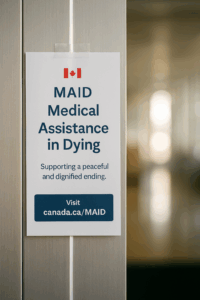The Price of Compassion, Canada’s Changing Landscape
Deno, a retired officer who had served his country with honor, found himself navigating the quiet aftermath of service in a world he barely recognized. His days were often filled with small routines, but recently, his digital world had grown louder. Messages and notifications poured in from fellow veterans—brothers and sisters who had operated and deployed beside him—echoing a new and troubling refrain: Medical Assistance in Dying (MAID) as a recommended solution for those battling Post Traumatic Stress Disorder (PTSD).
At first, Deno dismissed these stories as isolated incidents, but the frequency of the recommendations grew. Veterans he respected were being offered assisted death, not as a last resort, but as a practical choice. The realization chilled him: this was not an anomaly, but a trend. Was this what his country had come to? He thought the government seemed disturbingly eager to promote MAID, and the implications felt sinister.
Driven by a mix of disbelief and duty, Deno plunged into research. What he found shook him to his core. Canada, according to the latest statistics, was leading the world in the growth of MAID cases. The government openly projected staggering savings—over a trillion dollars—if millions of Canadians opted for MAID. It was a number so vast it felt surreal, yet the logic behind it was coldly pragmatic: people who chose assisted death did not linger in expensive hospital beds, did not draw years of pensions, and did not delay tax windfalls from their assets.
He realized that opting for MAID in their fifties instead of dying naturally decades later increased federal savings. The Parliamentary Budget Officer reported that Ottawa was already saving $149 million a year in healthcare costs thanks to MAID—a figure set to multiply rapidly. People who died early stopped collecting Old Age Security and Canada Pension Plan benefits, saving the government hundreds of thousands of dollars per individual. At the same time, the Canada Revenue Agency collected capital gains taxes decades ahead of schedule, as early deaths triggered the immediate sale and taxation of assets.
But the economic engine did not stop there. A cottage industry was blossoming around MAID: rental suites designed for a peaceful passing, funeral homes offering “celebration” packages, death doulas guiding clients through paperwork, lawyers crafting wills for scheduled deaths, and even travel agents booking MAID vacations. Deno saw a society where death itself was commodified—a system where compassion masked the reality of profit.
Organs, too, had become valuable resources. With MAID approved, Canada saw a surge in transplant activity, with half of the world’s population of transplants now performed there. Private centers billed staggering amounts for each surgery, and pharmaceutical companies thrived on lifetime prescriptions of anti-rejection drugs. All of it was legal, insured, and lucrative.
Deno grappled with the enormity of what he’d uncovered. Every early MAID case saved taxpayers wealth, fueled the transplant industry, enriched funeral directors, and delivered early tax revenue. This was no longer simply healthcare—it was a rapidly expanding profit center, dressed in the language of compassion and choice. This spoke to another realization; this is legalized organ trafficking.
He wondered, with mounting dread: Would Canadians see through the veil? Would they recognize the transformation of compassion into commerce, and the subtle pressure on vulnerable citizens—including children—to choose death? Deno knew his investigation was just beginning, but he felt a responsibility to speak out, to challenge the narrative, and to ask the nation: At what cost do we build this new economy?

Connect with us at https://social.thealliancepress.com/ and help us grow the community. Our platform is safe, secure, private and your data is yours. We the people run, maintain and are building this service. No government, corporation or three letter agency influence or clandestine operations.
Note: Spelling and words in the Graphic is on purpose.



